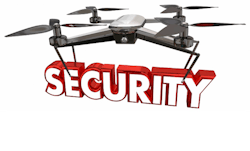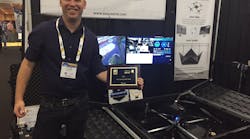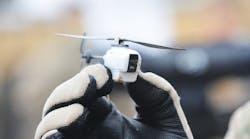Your next security guard might be a drone
The lowering cost of drones combined with lightweight video cameras and state of the art stabilization technology has opened up a wide range of use cases, including the integration of drones as a video surveillance tool for controlling your perimeter. In fact, drones have such a high potential for use in surveillance, that you may want to reconsider your staffing plans. Will drones have an impact on the contract security personnel market? It’s probably not as unlikely as you may think. Consider the following drone attributes and perhaps your next security guard selection may be a quadrotor.
More Efficient Communicators
A key to all security events is the timely, efficient understanding of pertinent details and the communication and assignment of actions in response to the event. In these situations, drones have an unfair advantage; details of the event and assigned actions are uploaded directly via software to the drone for immediate deployment. In the case of an intrusion, a geospatially-enabled video management system (VMS) can automatically inform the drone of the type of event (e.g. human intrusion) and the exact location of the event via GPS coordinates. The drone can immediately dispatch and fly to the exact event location using pre-defined flight routes or computer vision assisted free flight. Once there it can interrogate the scene, lock the camera on the intended target and wait for further instructions. In terms of first response efficiency, this scenario rates incredibly high, as it requires no humans in the loop and there is limited potential for miscommunication.
Fast “Runners”
Technically drones don’t “run,” but they have several unfair advantages when it comes to speed in getting to an incident. As previously mentioned, drones have the luxury of having dispatch commands uploaded automatically via a network connection. This gives them a jump on the start gun, versus a traditional incident response over a radio dispatch. Secondly, a typical surveillance drone has no issue matching the running speed of a security officer, with normal speed specifications around 30 to 40 mph. Finally, the greatest advantage is they are not constrained by land-based obstacles: landscaping, trees, cars, buildings, etc. Surveillance drones can operate up to 400’ in elevation, which allows for a point to point flight track for most facilities. Even if constrained to predetermined flight paths, drones still have a significant speed advantage over-responding by foot.
Superior Vision
Camera technology has improved by leaps and bounds over the last decade, and not only reductions in weight and size, but also in image resolution, sensor type, and image quality. A drone can collect millions of pixels of high-resolution data, along with a vast array of metadata about a scene, while it is in transit. Furthermore, today’s high-resolution visible light cameras can provide extensive image detail with better stabilization than the best handheld video. Zooms up to 30x add to this value proposition, allowing for more detail and the ability to perform more covert surveillance at a distance.
Thermal video has gone through a similar technology evolution, making these cameras small and affordable for perimeter surveillance drones. The use of thermal cameras provides for visual detection at night, difficult weather conditions, smoke and even through some vegetation. From a vision perspective, a drone definitely gets the upper hand.
Less Risk of Workman's Comp
Security and safety personnel have a long list of procedures and rules for responding to various situations. This is for the protection of the responder, bystanders, as well as the intruder. For the most part, drones are not constrained by these same rules. If an intruder runs into a dangerous location, makes a perilous jump or attempts to retaliate, a drone has no issues continuing to pursue in these conditions. Many times, this pursuit can be made without the intruder knowing they are being monitored and actively tracked.
Artificially Intelligent
The ability to utilize intelligent video and deep learning techniques to automate security measures are already in use within the security market. Drones get the benefit of this same technology. So, the ability to detect intrusions at great distances, in poor weather or in night conditions are part of its arsenal when responding to an event. Likewise, the use of camera following allows the drone to keep the intended target centered in the camera’s field of view, while both the drone and the intruder continue to maneuver. This can be performed simultaneously while receiving commands and transmitting stabilized real-time video back to the VMS. Although the drone isn’t necessarily “smarter” than a security guard, it does have an advantage in being able to perform more surveillance tasks independently.
But Drones Do Take More Coffee Breaks
Drones have some advantages when it comes to responding to events, but before you go out and purchase a division of drones, they do have some downsides to consider. One significant issue is their need to take a large number of coffee breaks due to short battery life. Typically drones can operate about 30 minutes before having to return for a charge. The act of recharging the batteries can then take several times longer than the duration of the flight. Higher-end drones can extend operation time to hours based on the weight of the payload and by limiting the actual time flying (versus hovering). In many cases, however, this proportionately increases the required time to charge the batteries.
OSHA Versus the FAA
The idea of not dealing with OSHA requirements, not squabbling over pay increases and avoiding annual performance reviews can be enticing, but drones come with their own form of oversight and “employment” rules. Drones operate in “airspace,” which in the United States, means the jurisdiction of their operation falls to the Federal Aviation Administration (FAA). These are the same guys that regulate and coordinate the complex system that is our air transport industry. To say the FAA has a few guidelines is an understatement. If you are unfamiliar, pick up a copy of the Federal Aviation Regulations (FARs) for some light bedtime reading. These same FARs apply to drones and although the FAA is trying to align the intended use with the level of oversight, be aware that it is not as easy as purchasing a drone, charging the batteries, reading the quick start guide and taking it for a spin.
Seriously Folks
Obviously, we are not likely to see entire security departments consisting of drones in the near future. However, much like other industries such as the driverless car market, there is a paradigm shift that needs to be made. What was unthinkable a few years ago is now a reality. Drones are very capable tools in the security arsenal, and although they won’t likely replace your security workforce, they will be able to perform many tasks previously done by human security guards, more efficiently and more rapidly. Is that a bad thing? That remains to be seen, but it is a reality which is here today, and it is technology we must consider keeping our facilities and people safe from harm’s way.
About the Author:
Eric Olson is Vice President of Marketing at Phoenix-based video analytics developer PureTech Systems (www.puretechsystems.com). He can be contacted at [email protected] or connect at www.linkedin.com/in/ericolsonaz.





